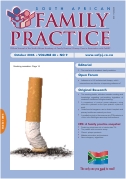A Comparison Of Cervical Smear Adequacy Using Either The Cytobrush Or The Ayre Spatula: A Practice Audit
Keywords:
Cervical smears, Ayre spatula, cytobrush, comparison
Abstract
Background To obtain an adequate cervical (Papanicolaou) smear, the squamous-columnar junction should be sampled as carcinoma develops preferentially in this transformation zone. The purpose of this study was to compare the adequacy of cervical smears taken with the Ayre spatula as opposed to the cytobrush. Methods This was a retrospective analytical study. One sampler, an experienced general practitioner, took the smears in the period 1990 to 2004. Initially, the Ayre spatula was used to consecutively sample the cervix and thereafter, a cytobrush alone was used. Two groups were thus formed for comparison. The presence of endocervical cells was accepted as an indicator of an adequate smear. Results A total of 4561 smears were taken and 247 had no endocervical cells. Of 2006 smears taken with a cytobrush, 1955 (97.5%) contained endocervical cells compared with 2325 (91%) of 2555 smears taken with an Ayre spatula. The difference was significant with an Odds Ratio of 4.56, 95% Confidence Interval 3.42-6.42. A further 34 smears classified as unsatisfactory due to degeneration (19), insufficient squamous cells (7), inflammatory exudate (4), excess blood (3) and a thick slide (1). Conclusions The cytobrush is significantly more efficacious than the Ayre spatula in obtaining adequate cervical smears. Use of the cytobrush will ensure less repeat smears.
Published
2006-11-30
Section
Original Research
By submitting manuscripts to SAFP, authors of original articles are assigning copyright to the South African Academy of Family Physicians. Copyright of review articles are assigned to the Publisher, Medpharm Publications (Pty) Ltd, unless otherwise specified. Authors may use their own work after publication without written permission, provided they acknowledge the original source. Individuals and academic institutions may freely copy and distribute articles published in SAFP for educational and research purposes without obtaining permission.

